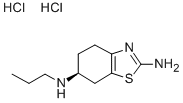
Pramipexole dihydrochloride
| Price | $1 |
| Package | 1KG |
| Min. Order: | 1G |
| Supply Ability: | 100KG |
| Update Time: | 2019-07-06 |
Product Details
| Product Name: Pramipexole dihydrochloride | CAS No.: 104632-25-9 |
| Min. Order: 1G | Purity: 98% |
| Supply Ability: 100KG | Release date: 2019/07/06 |
AD68
| Pramipexole dihydrochloride Basic information |
| Drug for treatment of Parkinson syndrome Toxicology Clinical evaluation of the treatment of Parkinson's disease Advanced Parkinson's disease (PD) Uses |
| Product Name: | Pramipexole dihydrochloride |
| Synonyms: | PRAMIPEXOLE DIHYDROCHLORIDE;PRAMIPEXOLE HCL;PRAMIPEXOLE HYDROCHLORIDE;PRAMIPEXOL HCL;(s)-2-amino-4,5,6,7-tetrahydro-6-(propylamino)benzothiazole dihydrochloride;PramipexoleDihcl;(S)-2-Amino-6-(propylamino)-4,5,6,7-tetrahydrobenzothiazol2HCltetrahydrobenzothiazol;(s)-4,5,6,7-Tetrahydro-N6-propyl-2,6-benzothiazolediamine, Dihydrochloride |
| CAS: | 104632-25-9 |
| MF: | C10H19Cl2N3S |
| MW: | 284.25 |
| EINECS: | 1806241-263-5 |
| Product Categories: | Antiparkinsonian;All Inhibitors;Inhibitors;Intermediates & Fine Chemicals;Pharmaceuticals;APIs;Chiral Reagents;Sulfur & Selenium Compounds;API |
| Mol File: | 104632-25-9.mol |
 |
|
| Pramipexole dihydrochloride Chemical Properties |
| Melting point | 288-290°C |
| storage temp. | Desiccate at RT |
| solubility | H2O: >20mg/mL |
| color | white to off-white |
| CAS DataBase Reference | 104632-25-9(CAS DataBase Reference) |
| Safety Information |
| MSDS Information |
| Pramipexole dihydrochloride Usage And Synthesis |
| Drug for treatment of Parkinson syndrome | Pramipexole hydrochloride is a kind of drugs for treatment of Parkinson syndrome. It belongs to selective non-ergot dopamine receptor agonist. It was first successfully developed by Boehringer Ingelheim Company (Germany). It is a prescription drugs of dopamine receptor agonist applied in the largest amount of the world. In May, 1997, it had been approved for the first time by FDA for the treatment of idiopathic Parkinson's disease. It can reduce the symptoms and sign, and can either be used alone or in combination with levodopa. The trade name of the good marketed in the United States is Mirapex, which is the first drugs approved the FDA during the past six years for treatment of Parkinson syndrome. In 2007, it has entered into market in China with the commodity name being sifrol for the treatment of the signs and symptoms of idiopathic Parkinson's disease, being used either alone (without levodopa) or in combination with levodopa. The two major efficacy characteristics of pramipexole hydrochloride in treatment of Parkinson's disease: 1. It can relieve the motor symptoms of Parkinson's disease: Parkinson's disease is cause due to the dopamine deficiency resulting from the loss of dopaminergic neuron, leading to patients get a series of symptoms such as tremors, muscle rigidity, slow movement and so on. Pramipexole hydrochloride can highly selective act on dopaminergic D2 and D3 receptors, thereby, stimulating the release of dopamine in the brain and alleviating the motor symptoms. Shannon et al have shown that early Parkinson's disease patients who has received pramipexole monotherapy can effectively have their motor symptoms be within control and can maintain daily living. When being used in combination with levodopa, pramipexole can effectively improve both the ADL score and the motor symptoms score of patients with advanced Parkinson's disease, and thus making the life of the patients with advanced Parkinson's disease more active. 2. it can significantly alleviate the depressive symptoms associated with Parkinson's disease: the pramipexole hydrochloride is a kind of agonists of dopamine D2, D3 receptor. The dopamine D3 receptor system may be associated with the patient's mood and behavior. Since pramipexole can selectively stimulate the D3 receptor with a higher agonist efficacy than D2 receptors, it can significantly relieve symptoms of depression. In study of Barone (Italy) et al, when patients with Parkinson’s disease had been treated with pramipexole or sertraline, the proportion of patients with alleviated depression symptoms in pramipexole group was significantly higher than that of the sertraline group. Researchers believe that dopamine agonists (pramipexole) can substitute antidepressants to treat the depression of patients with Parkinson disease. Pramipexole has protective effect on damaged neurons as well as excellent control of the jitter symptom. It has the least side effects in the field of Parkinson syndrome. Moreover, it has a large scope for adjusting drug in later phase, which is good for the following treatment. It can prevent the nerve damage caused by long-term use of levodopa, delaying the time needed for levodopa treatment as well as reducing the dose of levodopa. The above information is edited by the chemicalbook of Dai Xiongfeng. |
| Toxicology | Genetic Toxicity: The testing result of pramipexole in Ames test, HGRRT V79 gene mutation assay, CHO cell chromosome aberration test, mouse micronucleus test were all negative. Reproductive toxicity: within the fertility experiment, administration of rats with 2.5 mg/kg/day of pramipexole (according to the estimation based on mg/m2, this is equivalent to 5.4 fold of the maximum recommended human dose (1.5mg, tid)) causes estrous cycle extension as well as the reduction of the implantation rate. This may be related to the reduce serum prolactin levels caused by pramipexole (during the early phase of rat pregnancy, the embryo implantation and maintenance need prolactin while this is not required for human and rabbit). During the teratogenic sensitive period of pregnant rats,, administration of pramipexole in 1.5mg/kg day (based on the estimation of plasma AUC, this is equivalent to 4.3 fold of the AUC of maximum recommended human dose) can increase the incidence of total absorption fetal which may be related to that pramipexole can cause the reduced serum prolactin levels. During the teratogenic sensitive period of pregnant rabbits, administration of pramipexole in 10mg/kg/day (the plasma AUC is 71 times as high as the AUC of the maximum recommended dose of AUC) causes no abnormal behavior. During the perinatal period of pregnant rat, administration of pramipexole in 0.5mg/kg/day (based on the calculation of mg/m2, this is equivalent to the maximum recommended clinical dose for human) or higher doses has no adverse effect on the growth of rat offspring after birth. Carcinogenicity: applying drug-admixed food method to mouse and rat for administration of pramipexole in 0.3, 2, 10mg/kg/day (based on the calculation of mg/m2, this is equivalent to 0.3 fold, 2.2 fold and 11 fold, respectively of the maximum recommended dose of human ) or 0.3, 2,8mg/kg/day (estimated from plasma AUC, this is equivalent to 0.3 fold, 2.5 fold and 12.5 fold, respectively of AUC of the maximum recommended human dose) causes no increase in the incidence of tumor. |
| Clinical evaluation of the treatment of Parkinson's disease | Clinical trials including 4 placebo-control experiment has demonstrated the effectiveness of pramipexole in treating PD motor symptoms. A prospective clinical study in German had confirmed the efficacy of pramipexole in treating PD related akinesia, rigidity and tremors and other symptoms. The most rigorous and longest observation study comes from the Parkinson’s Research Group (PSG) of United States and Canada which had conducted four-year multi-center, double-blind, parallel, randomized, controlled study. This study compared the long-term efficacy of pramipexole and levodopa in treating early phase Parkinson’s disease when being used alone; the primary outcome variables: the first time when dopaminergic complications (loss efficacy, dyskinesia, and "switch" motor fluctuations) occurs, the change of the unified Parkinson's disease assessment scale (UPDRS) and scale of life quality. The analysis results after 2 years treatment had demonstrated that, the incidence of the dopaminergic complication in pramipexole group (28%) was significantly lower than that in the levodopa group (51%) (OR value 0.45, P <0.001);Compared with the baseline period, the overall UPDRS score of pramipexole group has increased by 4.5 points after two years which is significantly lower than that of the levodopa group (9.2) (P <0.001). After 4 years of analysis: the incidence of dyskinesia in the pramipexole group (24.5%) was significantly lower than that of the levodopa group (54%) (OR value 0.37, P <0.001). The incidence of decreased efficacy of pramipexole group (47%) was also significantly lower than that of the levodopa group (62.7%) (OR value 0.68, P = 0.02). However, the incidence of movement rigidity in the pramipexole group (37.1%) is greater than that of the levodopa group (25.3%) (P = 0.01); Compared with baseline, improvement in UPDRS score of pramipexole group after 4 years [(-3.2 ± 17.3) min] is lower than levodopa group [(2.0 ± 15.4) min] (0.03). In addition, no significant statistic difference has been observed for the two groups in improving the quality of life. Studies suggest that while pramipexole is slightly inferior t levodopa in alleviating the PD symptoms, but pramipexole can significantly reduce the incidence of complications of dopaminergic movement. Because younger PD patients have a high possibility of suffering from dopaminergic motor complications than elderly patients, younger PD patients should be subject to pramipexole monotherapy in early phase. |
| Advanced Parkinson's disease (PD) | It has been reported since 1995 that pramipexole is effective in treating patients with advanced PD. In 1997, Lieberman et al (United States) had published the results of a double-blind, placebo-controlled, multi-center study for evaluating the efficacy and safety of pramipexole in treatment of the advanced PD patients receiving levodopa but have already gotten symptom fluctuations. Study included 360 patients and results had showed that pramipexole can improve patients' motor symptoms during "on" and "off" period with reducing the "off" time as well as reducing the severity of the symptoms during the "off" period, enabling the reduction usage of levodopa. A 12-week domestic, multi-center, randomized, double-blind, bromocriptine-controlled clinical study on the efficacy of pramipexole in treating Parkinson's disease have found that, for the ratio of volunteers patients with UPDRS II-IV being larger than 30%, overall clinical evaluation as well as drug onset time, pramipexole was always better than bromocriptine (P <0.05). Europe has conducted a multicenter, double-blind, placebo-controlled study on the efficacy pramipexole in long-term treatment of patients with advanced PD. This study included a total of 354 cases of advanced PD patients who were receiving levodopa therapy but have already gotten symptom fluctuation, wherein 174 patients received the treatment of pramipexole and levodopa and 180 patients received placebo and levodopa treatment with observation period up to 57 months. The results showed that: Pramipexole can increase the II and III part of UPDRS score by 30% and reduce the “off” time in symptoms of fluctuations by 2.5 per day; Pramipexole can also significantly ease resting tremor. Moreover, 30.1% of the patients in the pramipexole group reduced the usage amount of levodopa while the ratio is only 12.8% in the placebo group. These studies suggest that pramipexole is effective in treating advanced PD as an adjunctive therapy to levodopa. The drug can not only effectively improve the motor symptoms of early and advanced Parkinson's disease, delay and reduce the occurrence and extent of levodopa-related motor complications, but also alleviate the symptoms of depression associated with Parkinson's disease. The drug has a rapid effect, long-lasting action with being safe for medication and small side effects. It is superior to bromocriptine in alleviating the symptoms of advanced PD dysfunction and has recognized and accepted by doctors and PD patients in clinical practice |
| Uses | It is used for treating Parkinsonism. It can also be used as pharmaceutical raw materials. |
| Chemical Properties | White Crystalline Powder |
| Uses | A dopamine-D2-receptor agonist. Antiparkinsonian |
| Definition | ChEBI: A hydrochloride that is the anhydrous dihydrochloride salt of pramipexole. |
Company Profile Introduction
Established in 2014,Career Henan Chemical Co. is a manufacturerspecializing in the sale of fine chemicals.
Mainly deals in the sales of:
Pharmaceutical intermediates
OLED intermediates:
Pharmaceutical intermediates;
OLED intermediates;
You may like
Recommended supplier
| Product name | Price | Suppliers | Update time | |
|---|---|---|---|---|
| $30.00/5mg |
VIP4Y
|
TargetMol Chemicals Inc.
|
2026-01-05 | |
| $1.00/1kg |
VIP3Y
|
Jinan Million Pharmaceutical Co., Ltd
|
2024-05-24 | |
| $10.00/1kg |
Hebei Linwo New Material Technology Co., LTD
|
2022-07-04 | ||
| $150.00/1ASSAYS |
Hebei Mingeng Biotechnology Co., Ltd
|
2021-12-24 | ||
| $1.10/1g |
VIP5Y
|
Dideu Industries Group Limited
|
2021-07-28 | |
| $15.00/1KG |
Zhuozhou Wenxi import and Export Co., Ltd
|
2021-07-10 | ||
| $0.00/1Kg/Bag |
VIP5Y
|
WUHAN FORTUNA CHEMICAL CO., LTD
|
2021-06-25 | |
| $0.00/1g |
Wuhan Nutra Biotechnology Co.,Ltd
|
2021-05-27 | ||
| $15.00/1KG |
Zhuozhou Wenxi import and Export Co., Ltd
|
2021-07-08 | ||
| $15.00/1KG |
Zhuozhou Wenxi import and Export Co., Ltd
|
2021-06-26 |
- Since: 2014-12-17
- Address: Zhengzhou High tech Zone, Henan Province, China
INQUIRY
杨俊青
sales@coreychem.com
sales@coreychem.com




![1-(6-Chlorophenyl-2,3,4,5-d4)-7-oxabicyclo[4.1.0]heptane](https://img.chemicalbook.com/ProductImageEN/2018-8/Large/db5b5bbd-5d2b-46ce-9032-e7f884bb46ad.jpg)


 China
China